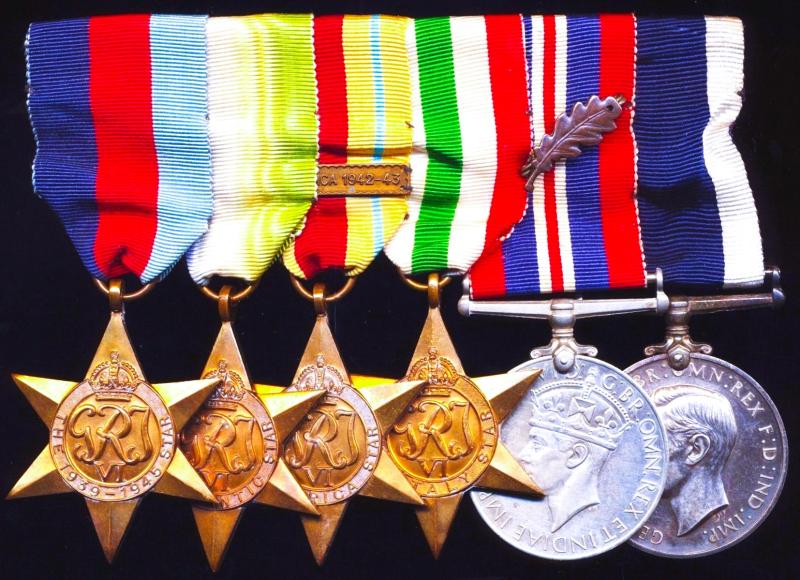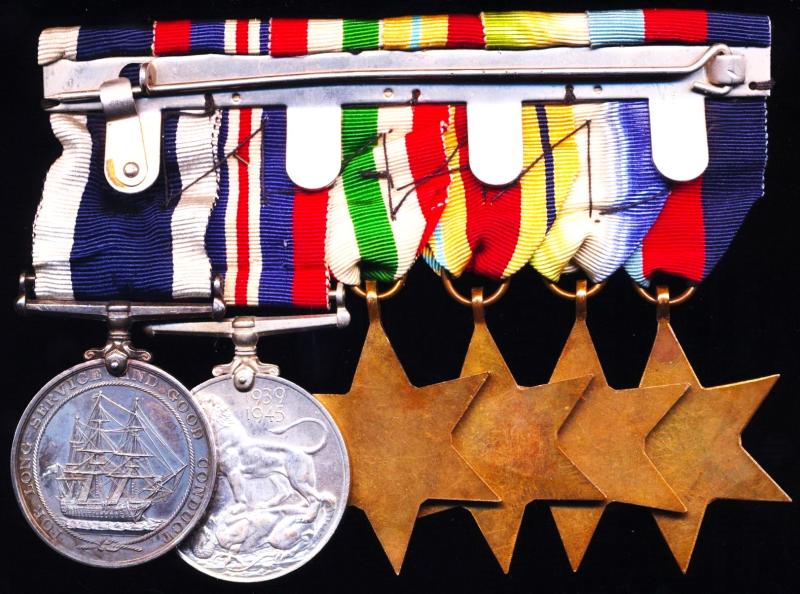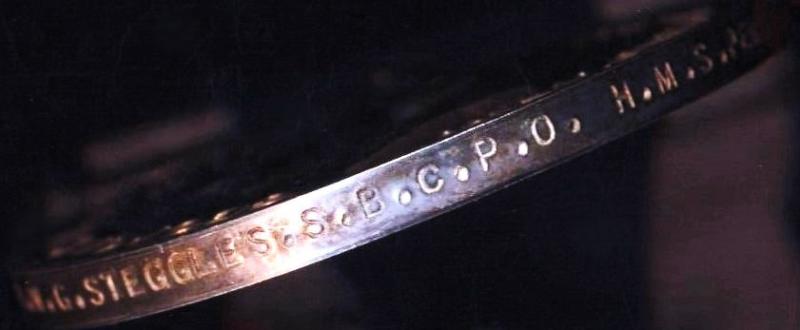A 'Decorated' Welsh Sick Bay Attendants 'Busy Naval War' including an 'Extraordinary Junket to the North West Frontier' medal group of 6: Sick Bay Chief Petty Officer Reginald William George Steggles, Royal Navy, late H.M.S. Kelvin
- The 1939-1945 Star. No clasp
- The Atlantic Star. No clasp
- The Africa Star. With clasp 'North Africa 1942-43'
- The Italy Star
- War Medal, With Mention-in-Despatches Oakleaf (M.I.D.) emblem
- Naval LS&GC Medal. GVI first type (MX.49384 R.W.G. Steggles. H.M.S. Pembroke.)
Mention-in-Despatches: The award to Leading Sick Bay Attendant Reginald William George Steggles, was published in the London Gazette issue of, 1 January 1941
Important: Reference 'Seedie's Roll of Naval Honours & Awards 1939-1959, revised edition (Ripley Registers 1999), it is confirmed that at the time of earning his M.I.D. that the recipient was serving aboard H.M.S. Kelvin
Medals verification:
Naval LS&GC Medal verification: Reference the respective Admiralty Medal Roll ADM 171/153 Medal shown as issued to recipient at H.M.S. Pembroke on, 3 December 1947
HMS Kelvin: Was a K-class destroyer of the Royal Navy laid down by the Fairfield Shipbuilding and Engineering Company, Limited, at Govan, Scotland on, 5 October 1937, launched on 19 January 1939 and commissioned on 27 November 1939 with the pennant number F37
Service history: Kelvin fought in several theatres during the Second World War. In September 1940, as part of the 5th Destroyer Flotilla she scuttled HMS Ivanhoe, which had struck a mine off 'Texel' (Netherlands coastline) during the Texel Disaster. In October, she was part of the escort for the battleship HMS Revenge when she shelled Cherbourg.
Under Admiral James Somerville, she was involved at the action off Cape Spartivento on 27 November 1940, and for the next two years she was busy in the Mediterranean Sea, being involved in many engagements. n May 1941, she bombarded Benghazi in company with the destroyers Jackal, Kashmir, Kelly and Kipling before heading to Crete on 20 May 1941. She survived the withdrawal with comparatively light casualties, but required repairs and was sent to Bombay during which time her crew had sufficient time to tour India as far north as the Khyber Pass, and entry into 'Tribal Territory'. So rare was a 'Matelot' seen on the North West Frontier, that it merited wry observation by Major Mott of the 1st Battalion Queen's Regiment then stationed at Razmak in the North West Frontier:
Quote,
On another occasion two lorries containing sailors overtook the column and, explained Major Mott, “This was a party from HMS ‘Kelvin’, a destroyer, whose stern was badly damaged off Crete and which had come to Bombay for repair. This took longer than expected and the Captain (who deservedly rose to at least Rear Admiral) decided that his men should not rot in Bombay, but should see a bit of India. The story went that by the time Their Lordships in England had answered his request in the negative, the party was out of touch in Kashmir. But we had the pleasure of entertaining the Royal Navy for a few days, and you can imagine how the ‘Excellent’ connection was exploited, if such an excuse was needed for us to have a party after all those weeks on column. And Buckshee Bill, the local sniper, entertained us all with a few rounds as we watched a garrison open-air entertainment, which was prematurely adjourned to Club, Messes and Canteens.
Unquote.
What the Matelot's thought of the legendary Pathan long range sniper 'Buckshee Bill' is not recorded, but given the sniper's atrocious 'hit' rate, they were probably safe enough under the protection of their Army host's
In March 1942 'Kelvin' was back in the Mediterranean escorting convoy MW10 which took part in the Second Battle of Sirte. Later in the year she was involved in diversionary attacks in support of Operation Pedestal and bombarded Rhodes. On 16 April 1942, Kelvin landed troops from the 11th Battalion of the Royal Marines at Koufonisi near Crete to destroy a W/T station (Operation Lighter). In December, in company with Janus, Javelin and Jervis, she sank the Italian torpedo boat Lupo off Kerkennah Bank, Tunisia. In January 1943, she bombarded Zuwara and in company with Nubian was responsible for sinking a variety of Italian supply ships and minesweepers. Then along with Javelin, Kelvin destroyed an Italian convoy on the night of 19 January 1943. Several members of her crew were decorated for their part in destroying enemy ships and aircraft in the Mediterranean. She returned to the UK for refit in Chatham in July 1943, recommissioning in March 1944. In June 1944 she carried Winston Churchill and various other dignitaries across the English Channel during Operation Overlord.She returned to the Mediterranean and took part in operations to liberate the Dodecanese. She bombarded Tilos and landed a party of Special Boat Service troops in November 1944
Reginald William George Steggles, son of Alexander Steggles and Steggles (nee Mills) was a native of, Cardiff, Glamorgan, Wales, where he was born in 1912. Reginald - while a serving member of the Royal Navy - married Zilpher K. Straw, at Medway, Kent, England, during the last quarter of 1938. At the time of the compilation of the National Registers for England & Wales in, 1939, Reginald is recorded employed as Leading Sick Berth Attendant R.N. MX43984 and living together with his wife (shown as an Export Clark employed with H.M. Dockyard) at, 10 Shottenden Road, Gillingham, Kent. Reginald Steggles is reported to have died at Westcliff-on-Sea, Essex, England, on 14 December 1979. At the time of his death he had been living at, 116 Hobbleythick Lane, Westcliffe-on-Sea
The medals mounted -as-worn by the recipient in the swing-style. The reverse of the mounting bar retaining its original long hinged pin & clasp fittings
Condition: Mostly about GVF
Code: 24327





